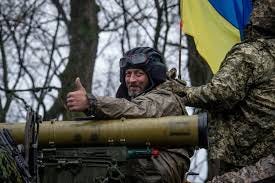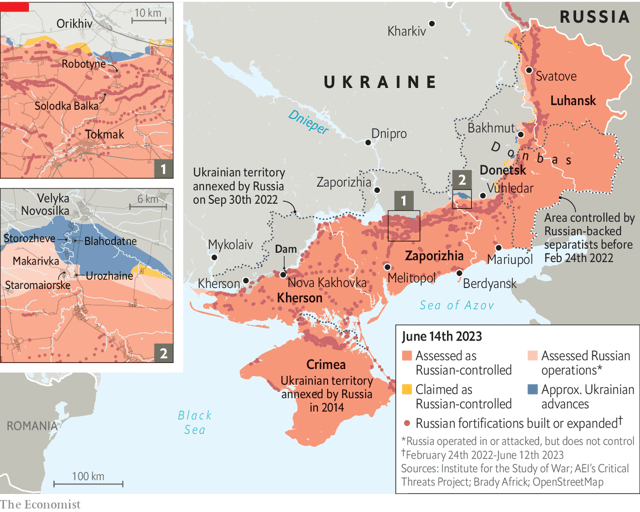As Ukraine’s counter-offensive enters its third week, its overall shape is becoming apparent: a three-axis advance, with the southernmost thrust, in Zaporizhska Oblast emerging as the main effort. Here Ukrainian forces launched their attack from Orikhiv southwest towards Tokmak, a rail hub that lies midway between their line of departure, and the Sea of Azov (see map). Beyond Tokmak lies Melitopol, a town that appears likely to the offensive’s main objective.
Fire-Sacks
The armed forces of the Russian Federation have demonstrated some well publicized shortfalls in the last year – but their areas of competence: tactical fires, electronic warfare, and defensive engagement areas –are now centerstage. To get to Tokmak, the Ukrainians must battle their way through more than 20 kilometers of well-prepared defenses designed to draw attackers into pre-prepared killing fields – or “fire sacks”, where the Russians – who lack sufficient manpower to launch a coherent counterattack – can instead bludgeon them with mortars and artillery.
Feints or Thrusts
The Ukrainians are attacking along two other avenues – one striking east towards Bakhmut and Luhansk Oblast and a second launched from Velyka Novosilka in Donetsk province aiming south and south-east. Although these appear to be subsidiary attacks, or feints designed to draw Russian reserves, both could potentially become the main effort if either succeeds in creating a gap in the Russian main defensive line.
Recapturing Bakhmut would remove Russia’s only substantial gain of the past year, and would be a huge humiliation for Putin who has made much of the town as a barometer for the war’s progress. A successful breakthrough in this area would also enable Ukraine to retake territory it lost in 2014 – undermining any claim that the war has served Putin’s stated purpose of “liberating Donbas.” Ukrainian forces would then be positioned to strike south towards the Sea of Azov, perhaps even as far as Mariupol, gateway to Crimea and the largest Ukrainian city still in Russian hands.
Slow Progress
The Ukrainians are making some gains – but measured so far in meters and single-digit kilometers – indicating that the Russian main defensive positions are still largely intact. The attackers, however, have the advantage of interior lines – the relative geographic placement that allows them to move men and material shorter distances than their adversary to get them where they are needed. They have yet to commit their reserves while the Russians don’t appear to have any reserves at all – at least none that they can commit in time to plug a gap anywhere along their 1,000-kilometer defensive line.
A Shifting Main Effort
Most of the attacks along each axis have involved Ukrainian units that were already in sector. Yet to appear is the type of large, western equipped armored formation that would indicate commitment of the main force. However, there have been reports of German Leopard tanks and Bradley fighting vehicles on the Zaporizhian axis, and Russian bloggers report sightings of French AMX-10 light tanks and British Mastiff mine-resistant personnel carriers in Donetsk. If these reports are accurate, then it appears that the Ukrainians have committed at least two of the nine Brigades trained and equipped by Western countries specifically for this offensive. That would support a theory that these attacks are not merely shaping, but probing for gaps in the main defensive belt with the intent to exploit immediately should one appear. It also suggests that any one axis could become the main effort if it starts to achieve significant success.
A Nut too Tough?
The Ukrainians may also decide to shift focus if Russian defensive positions in the south prove too tough to crack. Ukrainian officials concede that the fighting here has been especially difficult with the attackers incurring significant losses. Images published by the Russian ministry of defense show Leopard tanks and Bradley armored vehicles, caught in minefields, and being pummeled by Russian artillery. The defenders too are taking a beating. On 13 June, Vladmir Putin took the unusual step of mentioning Russian losses – which include, according to him, some 54 tanks, a number that exceeds all open-source estimates.
A Triumph of Ambiguity
There is no sanctuary in modern warfare: the proliferation of multi-domain sensors and long-range precision strike weapons make everyone and everything vulnerable. In Ukraine, both sides have learned to use dispersion and fortification to mitigate this risk by changing the cost versus gain calculus for the targeteer. But an attacker still has to leave his prepared positions to mass combat power if he is to stand a chance of exploiting through the enemy’s defensive positions.
The ability to locate an adversary across multiple domains and to remove him from play by multiple means, places primacy of combat operations back in the hands of the defense, in the same way that it did over a century ago at the beginning of the first world war.
The Ukrainians will have planned to use deception and ambiguity to mitigate the defender’s inherent advantage on this transparent battlefield. It is, perhaps, testament to their success that, three weeks into the offensive, military analysts around the world continue to speculate about it’s objectives.






The Ukrainians need to make an attack from behind, burn the country as Grant did in the civil war. The crops will recover, tell those loyal to Ukraine to flee and prepare their homes. There is fairness to Russian tactics and Ukrainians should not take the moral high ground.
"There is no sanctuary in modern warfare." Hopefully, whatever safe harbor currently enjoyed by those responsible for the cover-up of the worst Marine-on-Marine friendly fire incident in modern history doesn't last. I'd encourage you to listen to the podcast series NPR Embedded Taking Cover. Fallujah, April 12, 2004. Your dead fellow Marines and those who served alongside them, and their families, deserve better. Why isn't this incident being taught in the classrooms, Andrew? Don't we at least owe them that?